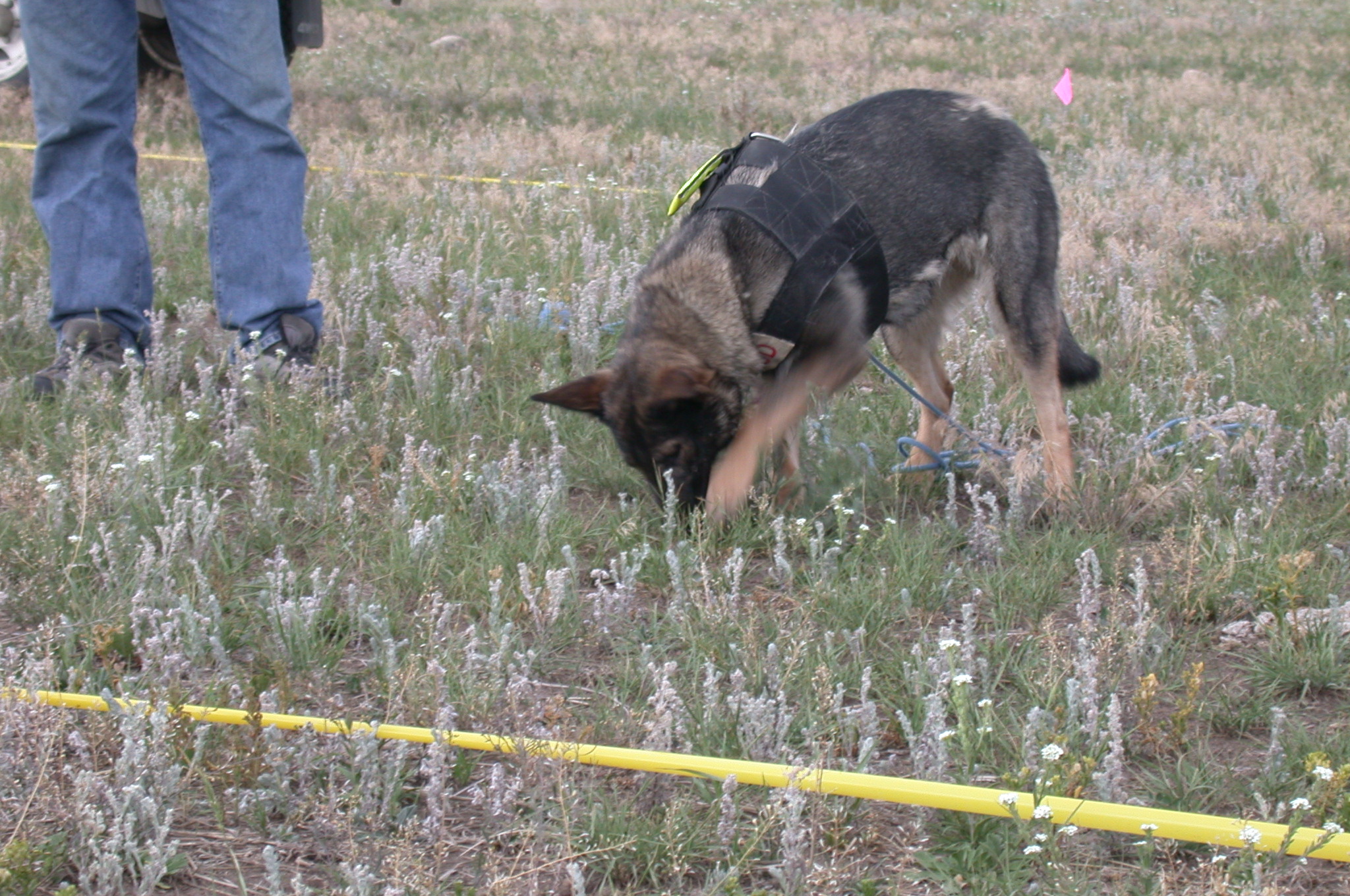Knapweed Nightmare on:
[Wikipedia]
[Google]
[Amazon]
Knapweed Nightmare was the first dog trained "to locate a plant within a plant community" which enabled her to track down low densities of invasive non-native noxious weeds.
Nightmare is a sable
 The concept that
The concept that
 For scent work training, her trainer Hal Steiner uses largely positive dog training methods. Without employing food rewards to entice the dog to search for the knapweed, a technique called "game theory" is employed. The dog's attention is fixed to a particular object, like a towel or a piece of plastic tubing that has knapweed wrapped inside. When the dog responds to the scented toy, handlers give her praise. The toy is then concealed in increasingly difficult-to-find locations.
The knapweed detection dog was taught a little differently than normal scent detection dogs- spending at least 10 seconds digging at a rosette of knapweed allows the
For scent work training, her trainer Hal Steiner uses largely positive dog training methods. Without employing food rewards to entice the dog to search for the knapweed, a technique called "game theory" is employed. The dog's attention is fixed to a particular object, like a towel or a piece of plastic tubing that has knapweed wrapped inside. When the dog responds to the scented toy, handlers give her praise. The toy is then concealed in increasingly difficult-to-find locations.
The knapweed detection dog was taught a little differently than normal scent detection dogs- spending at least 10 seconds digging at a rosette of knapweed allows the
 Phase One of the knapweed detection program was successfully completed and field-tested in the fall of 2004. Nightmare has a 93 percent success rate overall in locating the invading non-native spotted knapweed. She followed it up with 98% in the final trials in open fields, demonstrating that dogs can effectively detect low densities of invasive plants.
Phase One of the knapweed detection program was successfully completed and field-tested in the fall of 2004. Nightmare has a 93 percent success rate overall in locating the invading non-native spotted knapweed. She followed it up with 98% in the final trials in open fields, demonstrating that dogs can effectively detect low densities of invasive plants.
shepherd dog
A sheep dog or sheepdog is generally a dog or breed of dogs historically used in connection with the raising of sheep. These include livestock guardian dogs used to guard sheep and other livestock and herding dogs used to move, manage and co ...
trained by Montana based, Rocky Mountain Command Dogs.
Description
 The concept that
The concept that detection dogs
A detection dog or sniffer dog is a dog that is trained to use its senses to detect substances such as explosives, illegal drugs, wildlife scat, currency, blood, and contraband electronics such as illicit mobile phones. The sense most used by ...
could be used to sniff out invasive non-native weeds in the same manner they can be trained to locate drugs and bombs came from Kim Goodwin, weed prevention coordinator at Montana State University
Montana State University (MSU) is a Public university, public land-grant university, land-grant research university in Bozeman, Montana. It is the state's largest university. MSU offers baccalaureate degrees in 60 fields, master's degrees in 6 ...
Bozeman.
Goodwin pitched her idea of using dogs for locating spotted knapweed
''Centaurea stoebe'', the spotted knapweed or panicled knapweed, is a species of ''Centaurea'' native to eastern Europe, although it has spread to North America, where it is considered an invasive species. It forms a tumbleweed, helping to increa ...
(''Centaurea stoebe'') to a local dog trainer in 2003 and the two started working on the project. Nightmare, a shepherd dog in training for scent detection, was chosen to detect the invasive weed.
Process
global positioning system
The Global Positioning System (GPS), originally Navstar GPS, is a satellite-based radionavigation system owned by the United States government and operated by the United States Space Force. It is one of the global navigation satellite sy ...
(GPS) attached to her collar to indicate the location of a knapweed find.
Since Nightmare was expected to work on her own out in a large pasture locating small rosettes of knapweed as it invaded an area, she needed to be able to cover the field without chasing after wildlife or stray scents. As her proficiency increased, the trainers added various distractions, to help Nightmare learn to stay focused solely on her task.
Accuracy
 Phase One of the knapweed detection program was successfully completed and field-tested in the fall of 2004. Nightmare has a 93 percent success rate overall in locating the invading non-native spotted knapweed. She followed it up with 98% in the final trials in open fields, demonstrating that dogs can effectively detect low densities of invasive plants.
Phase One of the knapweed detection program was successfully completed and field-tested in the fall of 2004. Nightmare has a 93 percent success rate overall in locating the invading non-native spotted knapweed. She followed it up with 98% in the final trials in open fields, demonstrating that dogs can effectively detect low densities of invasive plants.
References
Further reading
*{{cite news , last1=Simon , first1=Scott , title=Russian Weed Proves a Nuisance in U.S. Northwest , url=https://www.npr.org/templates/story/story.php?storyId=1555312&wfId=1555312 , access-date=5 February 2023 , work=Weekend Edition Saturday , agency=NPR , date=20 December 2003 Individual dogs in the United States Detection dogs